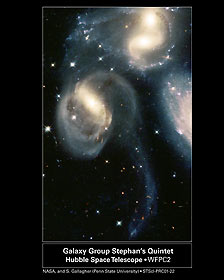
Enregistrez gratuitement cette image
en 800 pixels pour usage maquette
(click droit, Enregistrer l'image sous...)
|
|
Réf : S02265
Thème :
Galaxies (118 images)
Titre : Star Clusters Born in the Wreckage of Cosmic Collisions
Description : (La description de cette image n'existe qu'en anglais)
Star Clusters Born in the Wreckage of Cosmic Collisions. This close-up view of Stephan's Quintet, a group of five galaxies, reveals a string of bright star clusters that sparkles like a diamond necklace. The clusters, each harboring up to millions of stars, were born from the violent interactions between some members of the group. The rude encounters also have distorted the galaxies' shapes, creating elongated spiral arms and long, gaseous streamers. The NASA Hubble Space Telescope photo showcases three regions of star birth: the long, sweeping tail and spiral arms of NGC 7319 [near center]; the gaseous debris of two galaxies, NGC 7318B and NGC 7318A [top right]; and the area north of those galaxies, dubbed the northern starburst region [top left]. The clusters' bluish color indicates that they're relatively young. Their ages span from about 2 million to more than 1 billion years old. The brilliant star clusters in NGC 7318B's spiral arm (about 30,000 light-years long) and the northern starburst region are between 2 million and more than 100 million years old. NGC 7318B instigated the starburst by barreling through the region. The bully galaxy is just below NGC 7318A at top right. Although NGC 7318B appears dangerously close to NGC 7318A, it's traveling too fast to merge with its close neighbor. The partial galaxy on the far right is NGC 7320, a foreground galaxy not physically bound to the other galaxies in the picture. About 20 to 50 of the clusters in the northern starburst region reside far from the coziness of galaxies. The clusters were born about 150,000 light-years from the nearest galaxy. A galaxy that is no longer part of the group triggered another collision that wreaked havoc. NGC 7320C [not in the photo] plowed through the quintet several hundred million years ago, pulling out the 100,000 light-year-long tail of gaseous debris from NGC 7319. The clusters in NGC 7319's streaming tail are 10 million to 500 million years old and may have formed at the time of the violent collision. The faint bluish object at the tip of the tail is a young dwarf galaxy, which formed in the gaseous debris. The quintet is in the constellation Pegasus, 270 million light-years from Earth. Spied by Edouard M. Stephan in 1877, Stephan's Quintet is the first compact group ever discovered. The mosaic picture was taken by Hubble's Wide Field and Planetary Camera 2 on Dec. 30, 1998 and June 17, 1999.
|
|

